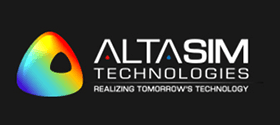At AltaSim Technologies, we believe in a simple but powerful idea: more engineers using simulation more often while obtaining credible results.
This is our working definition of the democratization of engineering simulation, a term gaining attention across industries. Technically, it refers to the significant expansion of simulation use by a broader range of users, especially those who can benefit from it but aren’t traditional simulation experts.
But in practical terms, democratization isn’t just about access. It’s about confidence in results. It’s about removing complexity so that simulation becomes as easy to use as a spreadsheet or a calculator. And most importantly, it’s about making the technology disappear, not literally, but in a way that it fades into the background as a natural part of the engineer’s toolbox.
The challenge: Expanding access without sacrificing credibility
Simulation software has historically been the domain of experts, engineers with deep knowledge of the physics, mathematics, and computational modeling behind each result. But the industry is shifting. Today, organizations want more of their engineers running simulations directly. And with that shift comes an urgent question: How do we ensure credible results when non-experts start running simulations?
At AltaSim, we’ve identified two proven approaches.
Approach No. 1: Build internal simulation expertise
Some companies choose to invest in building their own simulation teams. This means hiring full-time experts, purchasing the necessary software and hardware, and developing internal applications tailored to the company’s needs.
Benefits:
- Dedicated staff focused on simulation
- Long-term cost effectiveness (for organizations doing a high volume of simulations)
- Tailored, in-house tools that match specific processes
Challenges:
- High upfront investment in infrastructure and training
- Ongoing maintenance and skill development
- Significant demands on internal IT teams (who often aren’t prepared to support simulation environments)
Supporting simulation infrastructure isn’t like supporting standard engineering desktops. Software licenses are more complex, hardware requirements are greater, and internal IT departments often struggle to keep up. That tension is a consistent pain point we hear across the industry.
Approach No. 2: Work with external simulation experts
The second option is collaborating with an external team of simulation experts, like AltaSim.
Benefits:
- Rapid implementation
- No upfront costs for training, hardware, or licenses
- Highly flexible and scalable
- Access to specialists with deep, proven experience across industries
Challenges:
- Some companies are uncomfortable sharing intellectual property externally
- Long-term reliance on an external team may not be ideal for every business
- Potentially higher costs over time if the simulation volume is very high
This approach is perfect for organizations looking for a quick, focused solution, whether launching a new product, validating a design, or supporting internal teams needing immediate help.
How AltaSim makes a difference
At AltaSim Technologies, we support both paths. We help companies build their own internal simulation capabilities and provide on-demand simulation services as an external partner. We don’t believe in one-size-fits-all. We pride ourselves on recommending the best solution for the customer, even if that means less business for us.
A CEO once approached us, convinced his simulation engineer needed $10,000 in personalized training. However, when we evaluated the situation, we realized the engineer could reach his goal with just $5,000 in targeted consulting. That’s the route we recommended, because it was the right solution for the engineer and the company.
The real goal: Making simulation seamless
Democratizing simulation means making it as accessible and trustworthy as any everyday engineering tool. It means wrapping expert knowledge into applications that non-experts can use confidently. It means making technology vanish.
Whether you’re interested in building internal expertise or working with a flexible external partner, AltaSim is ready to make simulation work for you.
If you want to learn more, please join me by registering for my upcoming keynote, Empowering Innovation: The Role of Democratized Numerical Simulations in Engineering, at 11:45 a.m., May 1.
